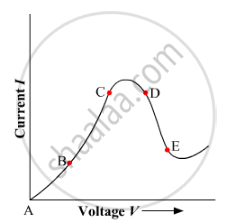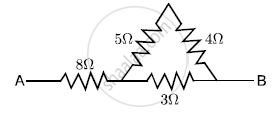Advertisements
Advertisements
प्रश्न
A wire of resistance 9 ohm having length 30 cm is tripled on itself. What is its new resistance?
उत्तर
Resistance (R) = 9 ohm
Length l = 30 cm
New Length (l) = 30 cm = `l/3` = 10 cm
New area an = 3a
`R = ρ 1/a`
Initial resistance `9 = ρ 30/a` ...(i)
New resistance `R_n = ρ 10/(3a)` ...(ii)
On dividing eqn (ii) by (i), we get,
`R_n/9 = (ρ 10/(3a))/(ρ 30/a)`
`R_n /9 = 10/90`
`R_n /9 = 1/9`
`R_n /1 = 9/9`
Rn = 1 Ω
Hence, The new resistance = 1 ohm.
APPEARS IN
संबंधित प्रश्न
Graph showing the variation of current versus voltage for a material Ga As is shown in the figure. Identify the region of
(i) negative resistance
(ii) where Ohm's law is obeyed.

Why are coils of electric toasters and electric irons made of an alloy rather than a pure metal?
A wire has a length of 2.0 m and a resistance of 5.0 Ω. Find the electric field existing inside the wire if it carries a current of 10 A.
How does an increase in the temperature affect the specific resistance of a :
(i) Metal and
(ii) Semiconductor ?
Calculate the effective resistance across AB?

What is non-ohmic resistor?
An ammeter placed in series with an electric radiator reads 0.5 amps and a voltmeter placed across it reads 230 volts. What is the resistance of the radiator?
What is ohmic device?
Write a short note on superconductors?
Obtain the macroscopic form of Ohm’s law from its microscopic form and discuss its limitation.
